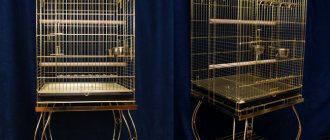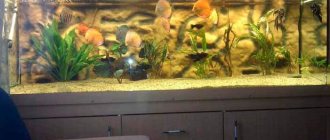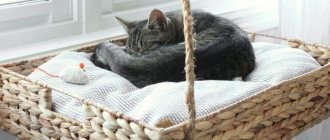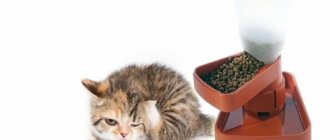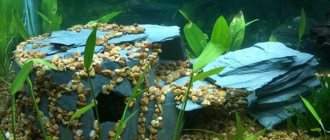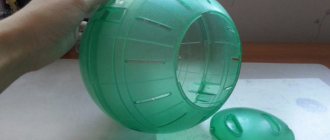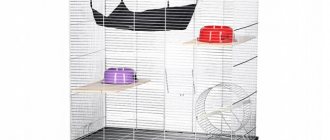Aquarium fish are a popular type of pet that require special care. In order for the fish to feel good, it is necessary to regularly add special food. However, in some cases, aquarium owners find themselves in a difficult situation when they need to be away from home for a long period. For such cases, special automatic devices are used. When buying a feeder, you need to choose the right device that will cope with the tasks. The rating of the best automatic feeders allows you to study the advantages and disadvantages of the models and make your choice easier.
General description of the device
Today, in pet stores, an automatic aquarium feeder is in great demand - a compact device that is autonomously capable of maintaining the functioning and life in the ecosystem.
Why do you need an automatic feeder?
This device is indispensable in the following situations:
- Absence from home – fish owners with irregular work schedules can entrust feeding their pets to automation. The device will take care of them on its own. An electronic feeder is also indispensable for those who often leave home for a long period of time, going on business trips or travel.
- Raising fry - breeding fish requires attention and responsibility from the aquarist. Feeding the brood should be done in small portions, but often. Not every owner has the opportunity to give food to teenagers every 3-4 hours, but a programmable device can handle this with ease.
- Maintaining cleanliness in the tank - due to the fact that food is supplied without excess (strictly in portions) in one place and time, the risk of contamination of the biotope is reduced. The fish get used to the regime and already gather at the feed introduction area in advance.
The automatic feeder keeps the aquarium clean. It is recommended to test a new device before leaving the house for a long time to make sure that the system does not fail.
Advantages and disadvantages of automatic feeders
Like any technology, an electronic device does not always meet all user requirements. The functionality of the device can manifest itself in different ways during operation, and at some stage it does not exclude interference in human work.
| Advantages | Flaws |
| Systematic nutrition | Feeding only dry food |
| Portion control | The mixture may become damp, spoil and cause poisoning. |
| Serving food in one place | There is a possibility that the device will become clogged, and then the fish will remain hungry |
| Ability to program time and frequency | If the program fails, too much food may enter the aquarium and the fish will die. |
| Autonomous operation up to a month | Flakes and tablets in some models need to be crushed |
There is always a risk of the device breaking down, so if you plan to be away for a long time, it is advisable to have someone periodically visit the house and check the functioning of the device.
When is a device for automatically feeding fish needed?
An automatic aquarium feeder is a device that can be useful to every fish owner. Such a device is required in the following situations:
- when the aquarium contains fish that require frequent feeding;
- if the owner of the aquarium is at work for more than 12 hours;
- in case of vacation, when there is no one to leave your pets with.
Such a device supplies the required dosage of feed in a timely manner. Which makes the care process easier. Feeders can be used in cases where the owner does not want to regularly monitor the process of feeding the fish, and prefers to use automated products.
The best automatic feeders for installation on the aquarium lid
An automatic feeder for aquarium fish, which is installed on the lid of the structure, is the most mobile version of the device. This model is less susceptible to moisture and is easier to maintain.
Ferplast Chef Pro+
The compact device has 3 automatic programs and additional options - mechanical feeding and standby mode. The set includes 4 nozzles for granules and flakes of different sizes. This patented development dispenses the mixture, since the model does not have any other type of portion adjustment.
The device uses batteries sparingly and signals when the battery is low.
Advantages:
- stylish design;
- feeding frequency from 1 to 3 times a day;
- easy maintenance.
Compact device, has 3 programs and additional options
Disadvantages:
- inadequate portions;
- feed gets wet.
SITITEK Pets Fish
Flexible settings and a large LCD display allow you to program the device for up to 99 days. Food is supplied to the aquarium forcibly or automatically 1-4 times a day. There are 9 dosing options available for serving volume, and to prevent product sticking, it is possible to connect a compressor.
Advantages:
- sound signal when food runs out;
- It is firmly fixed on the surface due to suction cups.
Disadvantage: design.
This automatic feeder beeps when the feed is low.
Juwel EasyFeed Juw-89000
An easy-to-use device with 2 programming cycles, designed for feeding fish at six-hour intervals or force-feeding. LED indicators indicate the selected mode and battery charge.
Advantages:
- reliability;
- simple settings;
- enough for 60 feedings.
Flaws:
- very bright LEDs;
- uncrushed flakes get stuck.
An easy-to-use device with 2 programming cycles.
The structure-mounted automatic feeder is suitable for aquariums that have a technical hole in the lid.
Is it worth making your own feeders?
Our answer is not worth it. An aquarium is a decorative structure and violating its design with self-made, and far from highly aesthetic (sorry if anyone was offended) “works” is not a rational way out of the situation. It will most likely not be possible to achieve the accuracy and reliability of industrial designs. Moreover, ordinary floating feeders are quite cheap. Of course, there is always an alternative to cutting out a feeder, for example from polystyrene foam, but polystyrene foam, firstly, crumbles, and secondly, absorbs dirt. After some time, such a feeder for aquarium fish will look completely unpresentable. If we talk about automatic feeders, then this task is also more for a professional, not only a mechanic, but also an electronics engineer. After all, a timer connected to an electric motor and setting it in motion after some time is also not a simple device.
The best universal models
Devices that can be installed in several ways are more practical to use. These models come with a clamp for installation on glass and fasteners (suction cups, Velcro, double-sided tape) for secure fastening to the aquarium lid.
Eheim Autofeeder
Stylish miniature model with LCD display. Feeds fish mechanically or automatically 4 times a day at programmed times. The features of the device from Eheim include double supply of the mixture with an interval of 1 minute per feeding.
Advantages:
- quality, design;
- low energy consumption.
This model feeds fish mechanically or automatically 4 times a day
. Disadvantages:
- sometimes it is necessary to fix the dispenser with adhesive tape to prevent an arbitrary increase in the portion volume;
- Not suitable for all feeds.
Tetra myFeeder
Automatic feeder with LCD display and many individual settings. Allows you to supply the dry mixture 1-3 times a day, depending on the settings, with the drum scrolling from 1 to 3 rotations. This model has a double body that protects food from moisture, light and air.
Advantages:
- uniform portions;
- wide range of settings.
Automatic feeder with LCD display and many individual settings
Disadvantages:
- the software malfunctions, which leads to constant rotation of the drum and complete emptying of the hopper;
- Not suitable for large feed.
Fish Feeder FD 55 Jebao
A universal device for feeding pond fish of any size. On the control panel, which is equipped with an LCD display, you can set the time, weight and number of servings (up to 9, 20-180 g each), and the number of feedings from 1 to 6 times a day. The device is protected from moisture and is designed for operation in open bodies of water; installation is carried out using a bracket to the wall or floor.
Advantages:
- holds up to 5.5 kg of nutritional mixture;
- smooth feed supply;
- Saving settings after power outage.
Disadvantage: high cost.
Universal device for feeding pond fish of any size
The best budget models
Inexpensive automatic feeders have the minimum functionality that is necessary to ensure that the pets are always fed in the absence of the breeder.
Homefish AF-101
An easy-to-maintain, programmed device that attaches to the glass of the aquarium and can force-feed the fish every 12 and 24 hours. Features of the model include the presence of two replaceable hoppers of different volumes: 50 and 100 ml.
Advantages:
- simple controls;
- feeds exactly on time.
This model has two replaceable hoppers of different volumes: 50 and 100 ml.
Disadvantages:
- rough dosing;
- works better with granules;
- It is difficult to remove the hopper to fill the mixture.
Resun AF-01
A small automatic feeder for installation on the wall or on the lid of the aquarium. Supplies power in the amount set by the user automatically - hourly interval 12/24 hours - and forcibly.
Advantages:
- one button control;
- miniature size.
Flaws:
- works better with medium fraction granules.
A small automatic feeder for installation on the wall or on the lid of the aquarium.
Any automatic feeder is designed not only for an aquarium with fish, the device is also suitable for feeding other underwater animals - turtles, frogs, newts.
The best automatic feeder for an average price – Feed-Ex FF03
Feed-Ex has been supplying certified automatic animal feeders to the Russian market for more than 10 years. The FF03 model is distinguished by rich functionality that is sometimes superior to expensive devices.
The automatic feeder works in real time and has:
- several feeding programs - constant, programmable by day from 1 to 99, forced (does not affect or cancel the settings for the subsequent introduction of the mixture);
- two options for dosing portions - from 1 to 9 in increments of 0.75 cm3 and without limiter 1.5 cm3;
- sound notification when the feeding cycle ends;
- Possibility of connecting a compressor.
The model is rich in functionality.
The model is universal and can be installed on the lid or wall of the aquarium.
The LCD display will always inform the user about the configured feeding schedule - programmed days, current feedings.
Best premium option – Eheim TWINfeeder
The German company Eheim, which later became an association, has been producing equipment for aquariums and ponds for more than half a century. Among the range of automatic feeders produced under this brand, the TWINfeeder model is popular. Featuring a large LCD display, this device has two separate dry food bins. Each compartment has its own operating algorithm - forced and automatic (from 1 to 3 times a day), the supplied volume is approximately a quarter of a teaspoon of the mixture. This portion is given for one rotation of the auger out of nine available for one feeding.
Features of the model include the ability to program one fasting day in the weekly diet of animals.
Advantages:
- simultaneous feeding of fish that live in the upper and lower water horizons and feed differently;
- autonomous programmable operation of bunkers.
Flaws:
- the model does not distinguish between days of the week and simply alternates established operations;
- Large tablets block the operation of the auger;
- Serving sizes may vary.
This model has autonomous programmable operation of hoppers
Comparison table of the presented models
In order to compare the presented models, we recommend taking a look at the table with their characteristics.
| Model | Manufacturer country | Feeding frequency (number of times per day) | Dimensions (cm) | Weight (g) | Price, rub) |
| Juwel | Germany | 2 | 14x6x8 | 32 | from 2435 to 3000 |
| Eheim | Germany | up to 4 | 14x6x6.5 | 360 | from 4450 to 6000 |
| Sera | Germany | until 6 | 21x14x10 | 505 | from 1900 to 2340 |
| Sitetek | China | 1-4 | 24x16x50 | 3050 | from 2500 to 3220 |
| Feed-Ex FF03 | Russia | 1-4 | 6x9x14 | 400 | from 2500 to 3200 |
What to look for when choosing an automatic feeder
The range of automatic equipment for artificial ecosystems is large, but the manufacturer does not always take into account all the needs of the aquarist for devices. Therefore, when considering a particular model for purchase, preference is given to devices that are most suitable in terms of characteristics and functionality.
So, the choice of feeder depends on a number of options:
- automatic mechanical operation;
- volume of the mixture hopper;
- the type and types of feed that can be used;
- adjustment, frequency and speed of serving portions;
- ventilation, degree of moisture protection of the housing;
- display, control unit;
- fastening method;
- power supply.
The electronic product must be suitable for the specific type of aquarium and satisfy the nutritional needs of all its inhabitants.
The automatic feeder must be suitable for the specific type of aquarium
The number of days for which the fish will be provided with food depends on the selected program, the capacity of the compartment for the nutritional mixture and the power supply.
DIY automatic fish feeder
Why do people buy automatic feeders for their aquarium pets? There are various reasons: being very busy at work, the desire to ensure that the feeding regimen is followed accurately, leaving for several days on business or traveling, etc. It would seem that the easiest option is to go to a pet store and buy one. But which feeder should you choose? Or maybe it makes sense to try to make it yourself?
Automatic feeder: general principle of operation
The operating principle of the device is based on portioned feed supply per unit of time. The mechanics of most modern automatic feeders are, in principle, the same: a strictly dosed portion of food is poured into the water through a hole in the drum.
After food is served, the drum rotates and its compartment is refilled from the common chamber. The capacity of the feed compartment is adjusted using a special curtain, which can be moved in one direction or another until a characteristic click is heard.
In addition to drum-type devices, there are:
- Fully automated automatic feeders with feed supply during the opening of a special shutter (like curtains in old mechanical cameras).
- As well as auger devices , when the dose of feed is regulated by the number of turns of the worm shaft.
- disk samples on sale , where food for fish is served sequentially from compartments on the disk. At a certain time, the lower disk rotates and all the food from one compartment is poured into the aquarium. Next up is the next drive bay.
Where to buy a fish feeder
The electronic feeder is sold in pet stores, in universal online hypermarkets, and in specialized departments of supermarkets.
A large selection of models is presented on online sites, there is always a wide range and affordable prices, and customer reviews often help to make the right choice.
Stores with sales floors sell a limited number of automatic feeders, but mostly these are devices that are in demand, which means we can assume that they are more reliable. In addition, there is a salesperson on the sales floor who will advise the buyer about the operation or options of the device and give his recommendations.
A large selection of automatic feeder models is presented on online platforms
Homemade
An alternative to store-bought feeders is a homemade fish feeder. If you can’t or don’t want to purchase a design in a store yet, you can make a feeder yourself. There are many options: from foam plastic, from plastic, from plexiglass, from a rubber tube.
Styrofoam
A DIY foam feeder is the simplest and most budget option. Find an old unnecessary piece of polystyrene foam, 1-1.5 centimeters high. Determine the size of the future feeder yourself, based on the number of fish and the volume of the aquarium. A frame is cut out of the piece, and all excess pieces of material are carefully removed.
Polystyrene foam holds up well on water, and if damaged, the structure can be easily replaced with a new one, also created with your own hands. The disadvantages of such a feeder are its fragility and the ability of the material to absorb dirt.
Rubber tube
This feeder will be more reliable than a foam one. It’s very simple to make it yourself: take a rubber tube with a diameter of about 1 centimeter. Bend the tube into a ring and secure the ends firmly.
A homemade tube design is more durable and more resistant to mechanical damage. But you need to carefully secure the ends of the tube, because if a little water gets into it, it will sink.
How to make a feeder yourself
Many fish holders decide to try to make such an automatic device in a homemade way, using the advice of resourceful inventors. You can make your own aquarium feeder from scrap materials that are easy to find in everyday life. There are two simple, but quite working ways to realize the possibility of automatically feeding fish.
For the first option you will need a plastic bottle and an unnecessary phone. The container is cut into two equal parts, then the lid is attached to the neck so that there is a gap between them. After this, a kind of bunker is filled with food, and a mobile phone is placed inside. The principle of the device is simple - food enters the aquarium due to vibration. To do this, several alarm clocks are set on the phone in silent mode, and at the appointed time the fish will get a portion of food. The amount of food is regulated by time - while the mobile vibrates, food arrives.
The second manufacturing method is more complex than the first and requires more materials:
- light weight alarm clock;
- plastic tube;
- dense polymer glass with a lid.
In this design, the glass will act as a drum.
How to make:
- A hole is made in the bottom of a plastic glass slightly smaller than the diameter of the tube.
- A tube is placed in the hole so that its end does not touch the walls of the glass.
- The container is filled with the feed mixture and closed tightly.
- The protective glass of the dial is removed from the alarm clock, and the drum is attached to the hour hand with tape so that in 24 hours the tube is turned to the water with its outer end twice.
Homemade automatic feeder from an alarm clock and a plastic container
The essence of the device is that the amount of food thrown into the aquarium is controlled by the size of the tube. The thicker the diameter, the more food the fish will receive.
It is recommended to test all devices for several days before use.
Why do you need a fish feeder in an aquarium?
A fish feeder for an aquarium is a small and practical plastic device into which the food mixture is poured. The product allows you to accustom the inhabitants of the aquarium to adhere to the diet. This has a positive effect on the health of the fish and allows them to live longer.
Other advantages of aquarium feeders:
- the food does not scatter throughout the aquarium and does not pollute the water, so it does not have to be changed often;
- ensures uniform absorption of food by fish;
- accustoms the inhabitants of the home pond to receiving food in the same place;
- using a feeder, it is easier for the owner to give live food;
- food residues will not settle to the bottom and in the corners, where they deteriorate and release elements unsafe for fish into the water.
A fish feeder is not a mandatory accessory for an aquarium, but since it greatly simplifies the conditions for keeping waterfowl, many owners purchase this accessory to equip the tank.
Where to install the feeder
Mount the automatic feeder according to the type of fastening as far as possible from the water to protect the device from splashes. This will not harm the device, but may negatively affect the quality of the feed. With high humidity, it will become damp, stick to the walls of the bunker, and mold.
During feeding, it is recommended to turn off the filter and compressor in the aquarium so that water flows do not carry the mixture. But since the purchase of an electronic device is mainly associated with the absence of the breeder at home, it is necessary to install the automatic feeder as far as possible from this equipment.
Automatic fish feeders are devices designed to make the aquarist’s life easier and prevent underwater inhabitants from starving. Devices for feeding feed can be purchased at the store, or built at home, but in the second case you need to make sure that the feeder is working properly.
Have you ever bought an automatic fish feeder? What brand was the device? How well did it work? Share your experience in the comments.
Tips for choosing
The selection criteria presented below will help you purchase a high-quality and effective automatic feeder.
- Fixation. The device must have convenient fastenings and be fixed in a place convenient for the owner. In the case where the feeder is equipped only with a certain fixation point, put it aside and look for another option. The aquarium can be replaced, and the automatic device that feeds the fish can serve you for many years.
- Ease of use. The device should be accompanied by clear instructions so that the aquarist can turn on and configure the device independently. The kit should also include all the necessary fasteners and suction cups.
- Reliability. The aquarium feeder must operate according to the specified settings, preventing random supply of food. This option, as a rule, is a little more expensive than its usual counterparts from China, but pets should not be at risk, which means the best option is a good and proven automatic feeder.
